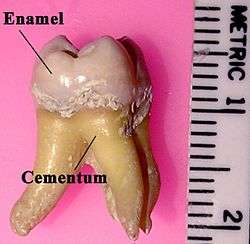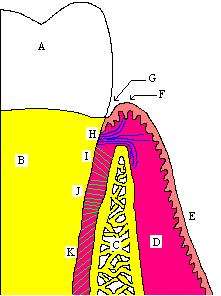Cementoenamel junction
| Cementoenamel junction | |
|---|---|
 Labeled molar | |
 The CEJ is the more or less horizontal demarcation line that distinguishes the crown (A) of the tooth from root (B) of the tooth. | |
The cementoenamel junction, frequently abbreviated as the CEJ, is a slightly visible anatomical border identified on a tooth. It is the location where the enamel, which covers the anatomical crown of a tooth, and the cementum, which covers the anatomical root of a tooth, meet. Informally it is known as the neck of the tooth.[1] The border created by these two dental tissues has much significance as it is usually the location where the gingiva attaches to a healthy tooth by fibers called the gingival fibers.
Active recession of the gingiva reveals the cementoenamel junction in the mouth and is usually a sign of an unhealthy condition.
There exists a normal variation in the relationship of the cementum and the enamel at the cementoenamel junction. In about 60–65% of teeth, the cementum overlaps the enamel at the CEJ, while in about 30% of teeth, the cementum and enamel abut each other with no overlap. In only 5–10% of teeth, there is a space between the enamel and the cementum at which the underlying dentin is exposed.[2]
References
- ↑ Clemente C (1987). Anatomy, A Regional Atlas of the Human Body. Baltimore: Urban & Schwarzenberg. ISBN 0-8067-0323-7.
- ↑ Carranza FA, Bernard GW (2002). "The Tooth-Supporting Structures". In Newman MG, Takei HH, Carranza FA. Carranza’s Clinical Periodontology (9th ed.). Philadelphia: W. B. Saunders. p. 43. ISBN 978-0721683317.